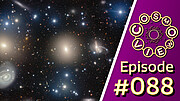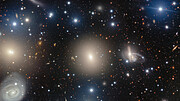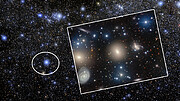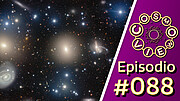An artist’s concept of a supernova remnant called Pa 30—the leftover remains of a supernova explosion that was witnessed from Earth in the year 1181. Unusual filaments of sulfur protrude beyond a dusty shell of ejected material. The remains of the original star that exploded, now a hot inflated star which may cool to become a white dwarf, are seen at the center of the remnant. The Keck Cosmic Web Imager (KCWI) at the W. M. Keck Observatory in Hawai‘i has mapped the strange filaments in 3-D and shown that they are flying outward at approximately 1,000 kilometers per second. Credit: W. M. Keck Observatory/Adam Makarenko
New observations probe a sphere of filaments around a dead star
Maunakea, Hawaiʻi – For nearly six months during the
year 1181, people looked up to the skies to find a new star glittering
in the constellation Cassiopeia. Chinese and Japanese astronomers
recorded the rare event, an explosion of a star, or supernova. In the
centuries since, astronomers have searched for the remains of the blast,
but it was not until 2013 that they were finally found. As part of a
citizen scientist project, amateur astronomer Dana Patchick—who had
sifted through images taken by the
now-retired Wide-field Infrared Survey Explorer, or WISE—found a nebula at the site where the supernova had occurred.
Further observations convinced astronomers that this nebula, called
Pa 30, was in fact the leftover ejected material from the 1181
supernova. Later, in 2023, astronomers discovered
strange filaments within the supernova remnant, which resemble the wispy tendrils of a dandelion flower.
Now, with the help of the Caltech-built
Keck Cosmic Web Imager
(KCWI) at the W. M. Keck Observatory on Maunakea, Hawai‘i Island,
astronomers have, for the first time, mapped the location of those
unusual filaments in three dimensions in addition to the speed at which
they are streaming outward from the site of the blast.
“A standard image of the supernova remnant would be like a static
photo of a fireworks display,” says Caltech professor of physics
Christopher Martin,
who led the team that built KCWI. “KCWI gives us something more like a
‘movie’ since we can measure the motion of the explosion’s embers as
they streak outward from the central explosion.”
Martin is a co-author of
a new paper reporting the findings published today in The Astrophysical Journal Letters.
The study is led by Tim Cunningham, a NASA Hubble Fellow at the Center
for Astrophysics |Harvard & Smithsonian (CfA), and the co-lead
author is Ilaria Caiazzo, a former Caltech postdoctoral scholar who
recently became an assistant professor at the Institute of Science and
Technology Austria.
In 1181, astronomers in China and Japan recorded a new star in the sky, a rare supernova explosion. The remains of that supernova, called SN 1181, are depicted here in this artist’s animation, which flies around the remnant as it appears today in one moment in time. The corpse of the star that detonated, a hot and inflated “zombie” star, is seen within a dusty shell of ejected material. Beyond the dusty shell, bright radial filaments of sulfur extend three light-years out from their point of origin. The Keck Cosmic Web Imager (KCWI) at the W. M. Keck Observatory has mapped these filaments in 3-D and shown that they are flying outward at approximately 1,000 kilometers per second. Credit: W. M. Keck Observatory/Adam Makarenko
The 1181 supernova is thought to have occurred when a thermonuclear
explosion was triggered on a dense dead star called a white dwarf.
Typically, the white dwarf would be completely destroyed in this type of
explosion, but in this case some of the star survived, leaving behind a
sort of “zombie star.” This type of partial explosion is called a Type
Iax supernova. “Because this was a failed explosion, it was fainter than
normal supernovae, which has been shown to be consistent with the
historical records,” Caiazzo says.
Material ejected in the 1181 explosion makes up the Pa 30 nebula that
astronomers observe today. While the scientists know that the peculiar
filaments, which glow with light from sulfur, were also generated by the
supernova, they do not know how and when they formed.
To probe the three-dimensional structure of the supernova remnant,
the astronomers turned to KCWI, an instrument that can capture
multiwavelength, or spectral, information for every pixel in an image.
This is like breaking apart the light captured in every pixel into a
rainbow of colors. The spectral information enabled the team to measure
the motions of the filaments poking out from the center of the explosion
and ultimately create a 3D map of the structure. The filament material
that is flying toward us shifted toward the blue higher-energy portion
end of the visible spectrum (blue-shifted), while light from material
moving away from us shifted toward the red end of the spectrum
(red-shifted).
This is analogous to the Doppler shift one can hear as a blaring
firetruck races by. As the vehicle moves toward us, the sound waves from
its horn become squeezed into higher frequencies; as the truck moves
away from us, the sound waves become elongated to lower frequencies.
Specifically, this study used the “red arm” of the KCWI instrument, which was
installed at Keck Observatory last summer.
KCWI consists of two halves: One captures light wavelengths at the blue
end of the visible spectrum, and the other half covers the red end in
addition to infrared light. “The addition of the red arm more than
doubled the spectral coverage of KCWI and made these observations
possible,” says Caltech graduate student and co-author Nikolaus
Prusinski. “This 3D map comprises the most sensitive spatial and
spectral measurements of Pa 30 to date and holds the current record for
the largest contiguous region surveyed with the red channel.”
The results showed that the filament material in the supernova is
flying outward from the site of the explosion at approximately 1,000
kilometers per second.
“We find the material in the filaments is expanding ballistically,”
says Cunningham. “This means that the material has not been slowed down
nor sped up since the explosion. From the measured velocities, looking
back in time, you can pinpoint the explosion to almost exactly the year
1181.”
The 3D information also revealed a large cavity inside the spindly,
spherical structure in addition to some evidence that the supernova
explosion of 1181 occurred asymmetrically.
As to how the filaments formed after the blast, the scientists are
still puzzled. “A reverse shock wave may be condensing surrounding dust
into filaments, but we don’t know yet,” says Cunningham. “The morphology
of this object is very strange and fascinating.”
About KCWI
The Keck Cosmic Web Imager (KCWI) is designed to provide visible band, integral field spectroscopy with moderate to high spectral resolution formats and excellent sky-subtraction. The astronomical seeing and large aperture of the telescope enables studies of the connection between galaxies and the gas in their dark matter halos, stellar relics, star clusters, and lensed galaxies. KCWI covers the blue side of the visible spectrum; the instrument also features the Keck Cosmic Reionization Mapper (KCRM), extending KCWI’s coverage to the red side of the visible spectrum. The combination of KCWI-blue and KCRM provides simultaneous high-efficiency spectral coverage across the entire visible spectrum. Support for KCWI was provided by the National Science Foundation, Heising-Simons Foundation, and Mt. Cuba Astronomical Foundation. Support for KCRM was provided by the National Science Foundation and Mt. Cuba Astronomical Foundation.
About W. M. KECK OBSERVATORY
The W. M. Keck Observatory telescopes are among the most scientifically productive on Earth. The two 10-meter optical/infrared telescopes atop Maunakea on the Island of Hawaii feature a suite of advanced instruments including imagers, multi-object spectrographs, high-resolution spectrographs, integral-field spectrometers, and world-leading laser guide star adaptive optics systems. Some of the data presented herein were obtained at Keck Observatory, which is a private 501(c) 3 non-profit organization operated as a scientific partnership among the California Institute of Technology, the University of California, and the National Aeronautics and Space Administration. The Observatory was made possible by the generous financial support of the W. M. Keck Foundation. The authors wish to recognize and acknowledge the very significant cultural role and reverence that the summit of Maunakea has always had within the Native Hawaiian community. We are most fortunate to have the opportunity to conduct observations from this mountain.



























